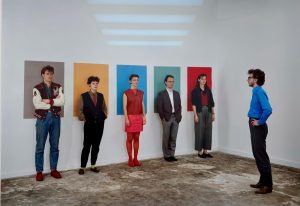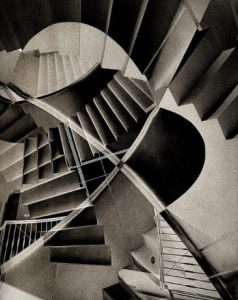For English Click here
הביקור בתערוכות הבוגרים השנה לא צפן הפתעות רבות אך גם לא איכזב – הרבה עבודות בינוניות מעט טובות, ומעט מאד גרועות.
מעל התערוכות בבצלאל, בשנקר ובסמינר הקיבוצים ריחף צלה הארוך של המלחמה והמהפכה המשפטית שלפניה. העובדה שכל או מרבית שנות הלימוד של הסטודנטים התנהלו בתקופה מתוחה, שהתרחש בה טבח ה 7 באוקטובר, הוזכרה בפתיח התערוכות. למרות זאת ככלל, לא היו עבודות פשטניות. רוח של מקצועיות ורצינות בעבודות רבות יצרה תחושה שדווקא כשמסביב סוער ושורר חוסר ביטחון הייתה התמקדות בעשייה עצמה, בחומר ולצד זאת דומה שאת התערוכות כיסתה גם שמיכה של שמרנות מסוימת , העדר פנטזיה.
העבודות הבאות הן חלק מאלו שבלטו לטובה:
עדן אברהם הציגה בבצלאל מיצב ללא כותרת, מגזעי עצים שרופים, דוקרני דורבן וצינור לבן.
אברהם יצרה סצנה שיש בה תנועה אצורה והיוצרת מקום ששומר מרחק בטוח מראליה אך קרוב מספיק כדי להטריד באלימותו המסוגננת. העצים השרופים מתקשרים ליערות השרופים הניבטים לכביש כעת הנסיעה לירושלים אבל גם לאין סוף יערות שרופים מהעבר, שובל אסונות שמקנן בזיכרון.
דוקרני הדורבן שתקועים- נטועים יוצרים הם ככתר קוצים לגזעים השרופים וכך הזיכרון של סבל וקורבן, דרך הדימוי שהוא נקודה ארכימדית בתרבות המערב – ישוע הסובל כד לכפר על החטא הקדמון מתחבר להווה. הצינור הלבן שמתנוסס באלכסון חריף כמעט במרכז הקשת שיוצרים גזעי העץ הופך לעמוד צלב או עמוד קלון ומתוכו נשפכות שערות. הגזעים עם הקוצים הופכים לחיה חדשה, ענקית ומאיימת ושאלת היחס בינה לבין העמוד הלבן מרתקת – הצינור יכול להראות לרגעים כמו חנית שנתקעה בקרקע, כמו סימון של מבנה.
לשימוש בחומרים של אברהם, החיבור של העץ השרוף, השיער ודוקרניי הדורבן, וגם תפיסת החלל איכות שמתקשרת לאמנות הגרמנית של המחצית השנייה של המאה הקודמת ובמיוחד לעבודות מרכזיות של בויס במיוחד THE END OF THE 20th CENTURY (1st version), 1982-1983 העשויה סלעי בזלת , והעבודה 7000 אלונים בהם הציב ליד כל עץ עמוד בזלת. אברהם הציבה את העבודה כך שגדר רשת חלק מהעיצוב (המאכזב ומקומם) של בניין בצלאל החדש הופך לחלק ממנה, כולא את התפרצות הכוח הזו, מונע ממנה לפרוץ כלוב.
עוד בלטו בתערוכת בוגרי בצלאל עבודות של כפיר גולדנברג, אגם זוארי , מאיה דונייק וסאן פרנקו, יובל קיילי ואביה בן אבי. בתערוכה זו הצליח האוצר, מעיין אליקים לשמור על מידה זיכוך שהקנה לה תחושה קוהרנטית בהרבה מאלו של בתערוכות בוגרים מקבילות בהווה ובעבר.



העבודות של שירה מרקוביץ זהרו בתערוכת בוגרי המחלקה לאמנות בשנקר. סידרת הצילומים “שיבוש פיוטי” (בהנחיית שירלי וגנר) מצוינת, חכמה ובעיקר תובענית – תובעת תשומת לב, תובעת עצירה מוחלטת ושקט מההתרחשות, מהרחש הבלתי פוסק, הרעש הלבן שלא חדל ללוות אותנו.
העבודות של מרקוביץ הן מערבולת צורות ודימויים מאובחנים שדומה שכוח צנטרפוגלי מושך פנימה למרכז לא ברור. שלל השפעות ניכר בהן ( כפי שניתן לצפות בעבודה של סטודנטית) א היופי הוא האינטגרציה והפרשנות שלה. אפשר לחשוב על מוהלי נאג’, טאטלין וצילום רוסי בכלל אך גם קולאז ופוטומונטאז של הנה הוך וראול אוסמן ומעבר לכך הקולונע האקספרסיוניסטי הגרמני של פריץ לאנג Fritz Lang ופרידריך מורנאו F. W. Murnau. מסקרן מאד לראות עוד מעבודותיה ולעקוב לאן תמשיך.
שירה קינן מציגה בסמינר הקיבוצים את She – She Tea Cermony מיצב וידיאו, טקסטיל, סאונד ופיסול שאפתני שניכרת בו שליטה רהוטה בכמה שפות חזותיות. אמנם בשם ובטקסט הנלווה ההתיחסות היא לטקס התה היפני וגם נטען שהעבודה נשענת על על מסורת הזן (“מתעקשת שלא להבלע בה”). חזותית ניכרת השפעה של הביתן האמריקאי, המוצלח מאד של Jeffrey Gibson בביאנלה בוונציה 2024, במיוחד עבודת הוידאו, השפעות של פיפי לוטי ריסט , נגיעות מהאסתטיקה המסוכרת של Wes Anderson ולרגעים משהו שמזכיר סרטים מוקדמים של מיקה רוטנברג.
קינן מכניסה את האלטר אגו שלה She – She למה שנראה כמו מסיבת תה של הכובען המטורף של אליסה בארץ הפלאות בהשראת TIK TOK ופופ קוריאני והיא יוצאת ממנו בשלום. גם אחריה יהיה מסקרן לעקוב.
עוד בלטו עבודות של דבורה גרשון, זהר דדון פרידמן ונעה זבדי.
כל הצילומים סמדר שפי (למעט צילום דבורה גרשון מתוך תיק עבודות מיח”צ סמינר הקיבוצים)


Highlights of graduation exhibitions 2025
My visits to this year’s crop of graduates’ exhibitions did not hold many surprises but neither did it let me down: there were numerous mediocre works, a few good ones, and very, very few bad ones. The long shadow of the war and the preceding anti-government protest hovered over the exhibitions at Bezalel, Shenkar, and the Kibbutzim College of Education. Most if not all of the studies were conducted during a tense period of time which included the October 7th massacre (2023), mentioned at the opening of each exhibition. Despite this, the works as a whole were not simplistic – there was a spirit of professionalism and seriousness in many of the works, which conveyed the feeling that it is precisely when everything around us is stormy and uncertain, that there was a focus on the making, the material, a certain conservatism and lack of fantasy.
The following works were among the highlights:

Eden Avraham showed an untitled installation at Bezalel, comprised of burnt tree trunks, porcupine quills, and a white pipe. She created a scene with restrained movement, creating a place maintaining a safe distance from reality but close enough to be disturbing in its stylized violence. The burnt tree trunks are associated with the burned forests visible from the highway on the way to Jerusalem but also refer to the infinite forest fires of the past, a wave of disasters inhabiting memory.
The implanted quills are stuck into the wood, forming a thorny crown to the burned trunks, bearing the memory of suffering and sacrifice, through an image that is the fulcrum of western culture: Jesus suffering to atone for Original Sin, connecting to the present. The white pipe rising in a sharp diagonal nearly at the center of the arc created by the trunks becomes the base of a cross or a stock. Hair falls out of it. The trunks with the quills become a huge, new, threatening animal; the relationship between it and the white pillar is fascinating. At certain moments, the pipe can seem like a spear stuck in the ground like marking a structure.
Avraham’s use of materials, the link to the burnt wood, the hair, porcupine quills and spatial perception are qualities link to German art of the second half of the 20th century, especially to Beuys’s major works. Especially strong are the associations to The End of the 20th Century (1st version, 1982-1983) made of basalt rocks, or 7,000 Oaks with a basalt pillar installed next to each tree. Avraham installed her work so that the mesh fence is part of the (infuriating and disappointing) design of the new Bezalel Building and becomes part of it. It cages the burst of power and prevents it from breaking through the confines.
Other works that stood out at the Bezalel graduates’ exhibition were those by Kfir Goldenberg, Agam Zoari, Maya Dunietz and San Franco, Yuval Keely, and Avia Ben Avi. Curator Maayan Elyakim succeeded in distilling enough to provide a feeling of much greater coherence than the feeling arising from other graduates’ exhibitions in the past and present.

Works by Shira Marcovitch shone in the otherwise unremarkable Shenkar Art Department exhibition. Her series of “poetic disruptions” (mentored by Shirley Wegner) is excellent, intelligent, and mainly demanding – the photographs demand attention and an absolute stop and quiet from the incessant murmur of the “white noise” that is constantly accompanying us.
Marcovich’s works are a whirlpool of forms and distinct images similar to centrifugal force drawing us into an unclear center. There are numerous influences on her work (as expected from a student) but their beauty lies in her integration and interpretation. One can think of Moholo-Nagy, Tatlin, and Russian photograph in general, but also Hannah Höch’s collages and photomontages, Raoul Hausmann, and beyond to German Expressionist cinema by Fritz Lang and F.W. Murnau. It will be intriguing to follow her as she continues her path.

Shira Keinan is showing her video/textile/sound/and sculpture installation She-She Tea Ceremony at the Kibbutzim College of education. It is am ambitious work with obvious fluent command of several visual languages. Although the title and accompanying text refers to the Japanese tea ceremony, the artist states that the work is based on the Zen tradition but is “insistent on not being swallowed up by it.” The visual influence of the very successful American pavilion by Jeffrey Gibson (Venice Biennale 2024) is evident, with influences by Pipilotti Rist especially in the video, touches of the saccharine aesthetics of Wes Anderson, and some moments that brought to mind early works by Mika Rottenberg.
Keinan brings her alter ego She-She into what seems like the Mad Hatter’s tea party from Alice in Wonderland inspired by TikTok and Korean pop and emerges successfully. It will be interesting to follow her career.
Also notable were works by Dvora Gershon, Zohar Dadon, and Noa Zevadi.
All photos by Smadar Sheffi (except for the photo of the work by Dvora Gershon from the Kibbutzim College PR kit








